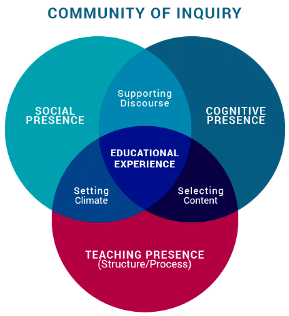If you’re new to virtual instruction, you will discover that the virtual learning environment provides opportunities for rich interaction between yourself and students, as well as on a peer-to-peer level. Of course, these interactions can vary depending on your teaching style, the tools available to you, and your students’ needs. In this article, Luke Cable, Senior Learning Designer for Wiley University Services, shares a teaching framework that can help you make a seamless transition to the virtual classroom. Wiley works with faculty to develop hundreds of online courses each year.
There is a seemingly endless number of ways to create meaningful teaching experiences in virtual classrooms. As you begin as a virtual instructor, it’s best to choose a learning framework that will simplify and clarify the teaching actions and decisions you will need to make. A research-based framework that has proven to be effective, useful, and robust is called Community of Inquiry (CoI).
What is the CoI Framework, and Why Is It Important?
Virtual, asynchronous classes that follow the CoI framework promote quality interaction between students, faculty, and course content. To use this framework, you will present the following components equally in each class: social presence, cognitive presence, and teaching presence. As the following sections show, these components encourage student interaction and the development of critical thinking and reflection (Garrison, 2005).

Social Presence: Student-to-Student Interaction
Building social presence into your course means creating connections between students. These connections can be personal or emotional, while fostering peer-to-peer learning. From an academic perspective, social presence allows students to become visible to classmates and instructors as they express themselves during discussions and group work (Dixson, M. 2010). It also supports learning objectives in ways that make group interactions enjoyable and rewarding (Barber, T. 2011). Social presence indicators include emotional expression, open communication, and group cohesion.
To establish social presence in a course, you can:
- Look for opportunities for students to incorporate their personal and professional experiences into coursework.
- Encourage students to use video during live sessions and certain types of assignments.
- Create a dedicated discussion forum to serve as a “student lounge” that fosters engagement beyond assignments.
- Design collaborative activities such as debates, group presentations, and group activities that allow students to apply their knowledge and skills.
Activities That Foster Student-to-Student Interaction
- Sharing backgrounds and insights
- Problem-solving
- Group work
- Cooperative learning
- Collaborative learning
Cognitive Presence: Student-to-Content Interaction
Cognitive presence is defined as “the extent to which learners are able to construct and conform meaning through sustained reflection and discourse” (Barber, 2011). All courses have content, such as lectures, handouts, and textbook readings. But passive interaction with content doesn’t promote deep or meaningful learning. Where possible, identify ways for students to grapple with the content to spur them to think about their thinking, a process known as metacognition. These exercises also push students to challenge their perception of concepts. Additionally, you can provide opportunities for reflection through student journals and class-wide discussions.
Methods for enabling students to engage with content include (Garrison, Anderson, and Archer, 2000):
- Providing a triggering event. Give a sense of puzzlement and confusion around a situation by posing an open-ended question about a topic. Example questions: How do we know that a tax system works? What might invalidate this experiment?
- Encouraging exploration. Have students search for clarity through research and information exchanges. Give them an assumption to validate or invalidate.
- Finding integration. Make connections between concepts and ideas that evolve into an understanding of acquired knowledge. These connections can tie to prior experiences, but seek ways for students to make them through analogies and stories.
- Working toward resolutions. Have students apply ideas and make a critical assessment of solutions (Barber, 2011).
Teaching Presence: Student-to-Teacher Interaction
By analyzing years of student feedback, we’ve found that instructors can make or break the learning experience in online courses. You can improve the student experience tremendously by being a responsive, engaged instructor. Students want to hear from you directly via feedback on assignments and messages sent through the LMS or by email. Be sure to connect with them routinely so they know you’re there. This engagement is the most important part of teaching presence: Be present in your virtual classroom.
Your role as a virtual instructor is similar to the one you serve in the physical classroom. But you’ll take a different approach as you engage, teach, and motivate students from afar. You can succeed as an online facilitator by synthesizing and extending discussions, providing timely feedback on assignments, and encouraging students to take part in the virtual environment.
Routine ways to engage and motivate students include:
- Posting regular announcements. Examples include posts that answer common questions and connect course topics to current events. Boost engagement by recording video posts using your smartphone or laptop.
- Checking in frequently. Offer regular support and feedback to individual students and the entire class.
- Taking part in student-discussion forums. Nudge the discussion forward with open questions. Add your voice and expertise without controlling the conversation.
- Holding video conference office hours. Be sure to keep a regular schedule so students know they can connect with you directly.
Conclusion
Leveraging the CoI framework makes transitioning from face-to-face to virtual instruction less daunting. It also helps you create engaging learning experiences for virtual students. To access more resources that draw from Wiley’s expertise in online learning, visit our Virtual Instruction Resource Center.
References
Barber, T. (2011). The Community of Inquiry Meets Design Education The Journal of Distance Education. 25, 1.
Dixson, M. D. (2010). Creating effective student engagement in online courses: What do students find engaging? Journal of Scholarship of Teaching and Learning, 10(2), 1–13.
Garrison, D. & Cleveland-Innes, M. (2005). Facilitating Cognitive Presence in Online Learning: Interaction Is Not Enough The American Journal Of Distance Education, 19(3), 133–148.
Additional Resources
Inquiry Based eLearning – The eLearning Coach Blog: http://theelearningcoach.com/elearning_design/inquiry-based-elearning/
Mandernach, B., Gonzalez, R. & Garrett A. (2006). An Examination of Online Instructor Presence via Threaded Discussion Participation. Retrieved March 1, 2011 from http://jolt.merlot.org/vol2no4/mandernach.htm MERLOT Journal of Online Learning and Teaching V2, 4.
Richardson, J., Arbaugh, J., Ice, P. & Swan, K. (2010). Using the Community of Inquiry Framework to Inform Effective Instructional Design AECT 2010 Summer Research Symposia.
Shea, P. J., Fredericksen, E. E., Pickett, A. M., & Pelz, W. E. (2003). A preliminary investigation of “teaching presence” in the SUNY learning network. In J. Bourne & Janet C. Moore (Eds.), Elements of Quality Online Education: Into the mainstream, 4, (pp. 279-312). Needham, MA.: Sloan-C.

















